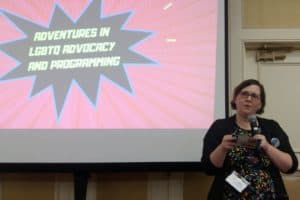
When searching for health information online, one out of every two teens clicks on the first site they find, according to the Pew Research Center. These teens only click further if they have questions. Jarrod Irwin, consumer health coordinator at the National Network of Libraries of Medicine, Southeastern/Atlantic Region, thinks this is one of many statistics that make a compelling case for librarians to help teens with health literacy.
“That can often mean supporting other types of literacy,” such as digital literacy or numeracy, Irwin said at “From A(ddiction) to Z(its): Health Information and Programs for Teens,” a session he presented at the Young Adult Library Services Association’s (YALSA) Symposium in Memphis, Tennessee, on November 3.
“You don’t want to provide health advice because you are not a doctor,” Irwin stressed. “You don’t want to do things like recommend treatments. But you can provide health information.”
The three health topics that teens seek information on most frequently, according to a 2015 Northwestern University study,are fitness and exercise, diet and nutrition, and stress and anxiety, followed by sexually transmitted infections, puberty, sleep, and mental health. Further, 55% of teens get health information from a source more popular than the internet—their parents.
“What you see in your communities may be different from what these averages suggest,” said Irwin. He offered tips for anticipating different types of questions (knowledge, values, and “is this normal?” questions) and how to approach conversations in a manner that gets at the heart of what teens want to know. For instance, Irwin said, “‘Why am I having these dramatic mood swings?’ could be a knowledge question, or it could be an ‘is this normal?’ question in disguise.”
One tactic to use for health queries, he said, is the ABLE method: answer the question if you can; be brief and to the point; leave the door open to more conversation; and end with a supportive statement. Key to the interaction is providing a welcoming and nonjudgmental space while maintaining professional boundaries and offering a range of authoritative materials.
“You can be a confidant, but you can’t be a peer,” said Irwin. For example, by saying “here are my hours at the reference desk” when a teen has a question, you set a boundary without seeming imposing or threatening.
Online resources such as MedlinePlus, KidsHealth.org, and girlshealth.gov are good places to start—as is listening to your patrons. “Ask teens directly what kind of programs they want the library to have,” Irwin suggested.
Cultivating understanding
In Marion, Iowa, there are only two places for teens to hang out: the public library and a public park across the street from the library.
“What kind of message does that send [to teens]?” asked Rachel Pollari, full-time teen services assistant at Marion Public Library (MPL), at the YALSA Symposium “YAK About It!” session.
Pollari and Shanel Slater, part-time teen services specialist at MPL, take their responsibility to provide a welcoming teen space in a growing community seriously. Cordoned off in the back of their library is an area outfitted with videogames, “a big pink dog,” and whiteboards, which sees 20–40 young adults per day. But with an increase in attendance came a few negative behavioral issues, including teens physically fighting and using racial slurs.
So Pollari and Slater started a talking circle.
“We wanted to rebuild those relationships,” said Slater. “We thought it would be good if they had a community to discuss the loneliness and isolation [they were experiencing].”
Rooted in Indigenous tradition (which Pollari and Slater acknowledged, and explained that their model is not meant to be a replica), talking circles foster open-mindedness, listening, and respect. “Our talking circle program aims to build a space that is vulnerable, open, and honest,” said Pollari. The program was titled Youth Advocating Kindness, or YAK for short.
To illustrate their talking circle framework, Pollari and Slater called seven audience volunteers to the front of the room, sat them in a semicircle, and went through the steps of conducting a circle in order: physical calm; opening the circle and setting the tone; establishing guidelines and agreements (including “you don’t have to speak if you don’t want to or don’t feel comfortable”); being mindful of facilitator status; a check-in round (“it’s great to use low-risk questions,” said Pollari); guided conversation; personal conversation; and checking out.
Personal conversations among teens in the YAK group have so far included issues as wide-ranging as new playground equipment, coming out to one’s parents, and how the Marion community views teenagers.
“Sometimes silence is okay,” Pollari was quick to mention, “because it’s an important part of processing and listening.”


